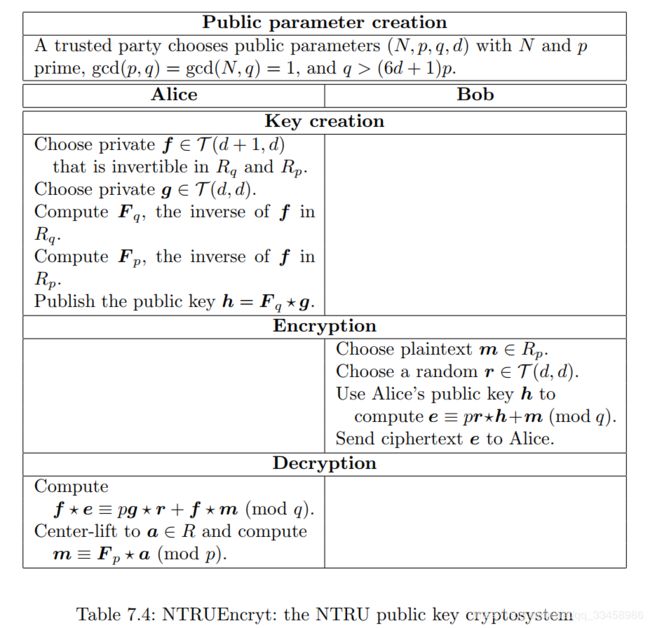Lattices and Cryptography(格理论与密码学)
本文是阅读 Introduction of Mathematical Cryptography Second Edition 一书中关于格密码一章的Review,只讲述简单的总结,具体内容请翻阅该书的第七章(下文中大部分图片均来自此书)
同余密码体系与背包密码
同余(Congruence)密码 流程如下,可以看做一个低维的格密码,破解该种密码可以相当于找一个向量,这个向量就是私钥
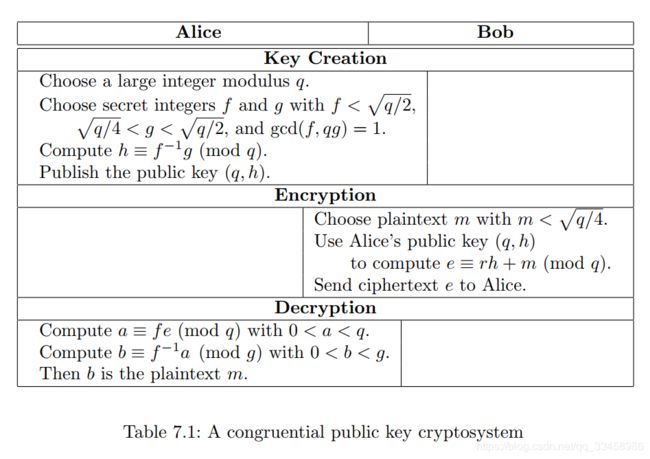
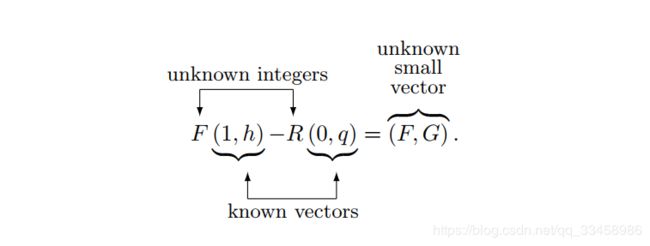
将上面这个问题用向量的形式写出来,就是要找一个 a 1 , a 2 ∈ Z a_1,a_2\in \mathbb{Z} a1,a2∈Z来找到一个小的向量,如下面的表达式所示
L = { a 1 v 1 + a 2 v 2 : a 1 , a 2 ∈ Z } L=\{a_1v_1+a_2v_2:a_1,a_2\in\mathbb{Z}\} L={a1v1+a2v2:a1,a2∈Z}
使用格理论可以解出。
背包密码 (Knapsack Cryptosystem)关注于背包问题,一个简单的例子是Subset-sum problem,在这一章里作者举出了Merkle-Hellman subset-sum cryptosystem作为例子,如下所示:
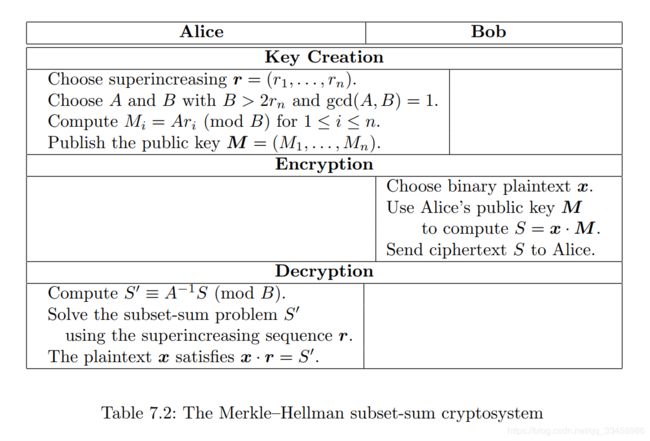
要破解这个密码系统,我们要根据密文S获得明文 x \boldsymbol{x} x,就是说找到一个 x = ( x 1 , … , x n ) \boldsymbol{x}=\left(x_{1}, \ldots, x_{n}\right) x=(x1,…,xn) ,使得 S = x 1 m 1 + x 2 m 2 + . . . + x n m n S=x_1m_1+x_2m_2+...+x_nm_n S=x1m1+x2m2+...+xnmn,将问题转换为下面的向量问题:
v 1 = ( 2 , 0 , 0 , … , 0 , m 1 ) v 2 = ( 0 , 2 , 0 , … , 0 , m 2 ) ⋮ v n = ( 0 , 0 , 0 , … , 2 , m n ) v n + 1 = ( 1 , 1 , 1 , … , 1 , S ) \begin{array}{c} {\boldsymbol{v}_{1}=\left(2,0,0, \ldots, 0, m_{1}\right)} \\ {\boldsymbol{v}_{2}=\left(0,2,0, \ldots, 0, m_{2}\right)} \\ {\vdots} \\ {\boldsymbol{v}_{n}=\left(0,0,0, \ldots, 2, m_{n}\right)} \\ {\boldsymbol{v}_{n+1}=(1,1,1, \ldots, 1, S)} \end{array} v1=(2,0,0,…,0,m1)v2=(0,2,0,…,0,m2)⋮vn=(0,0,0,…,2,mn)vn+1=(1,1,1,…,1,S)
L = { a 1 v 1 + a 2 v 2 + ⋯ + a n v n + a n + 1 v n + 1 : a 1 , a 2 , … , a n + 1 ∈ Z } L=\left\{a_{1} \boldsymbol{v}_{1}+a_{2} \boldsymbol{v}_{2}+\cdots+a_{n} \boldsymbol{v}_{n}+a_{n+1} \boldsymbol{v}_{n+1}: a_{1}, a_{2}, \ldots, a_{n+1} \in \mathbb{Z}\right\} L={a1v1+a2v2+⋯+anvn+an+1vn+1:a1,a2,…,an+1∈Z}
当 x = ( x 1 , … , x n ) \boldsymbol{x}=\left(x_{1}, \ldots, x_{n}\right) x=(x1,…,xn) 是明文,我们可以得到L变为 t \boldsymbol{t} t
t = ∑ i = 1 n x i v i − v n + 1 = ( 2 x 1 − 1 , 2 x 2 − 1 , … , 2 x n − 1 , 0 ) \boldsymbol{t}=\sum_{i=1}^{n} x_{i} \boldsymbol{v}_{i}-\boldsymbol{v}_{n+1}=\left(2 x_{1}-1,2 x_{2}-1, \ldots, 2 x_{n}-1,0\right) t=i=1∑nxivi−vn+1=(2x1−1,2x2−1,…,2xn−1,0)
根据比对L中所有可能的结果,我们可以知道 t \boldsymbol{t} t是L中所有可能结果中长度最小的向量,这样的话,也可以使用格理论来解出明文。
背包问题是一个难解的 N P − c o m p l e t e \mathcal{NP}-complete NP−complete 问题,一般而言不适合用来做密码系统,因为它没有trapdoor(可以理解为秘钥),但是书中的例子选用了superincreasing的公钥,使得拥有私钥的人可以很快地得出明文
向量空间
略
格理论
Lattice的定义如下

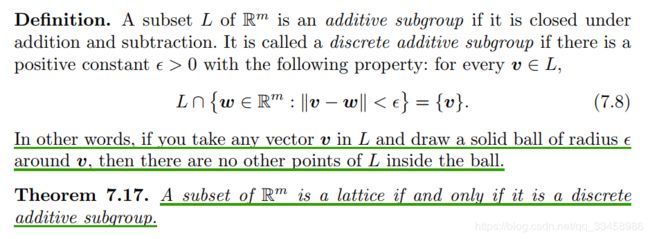
从第一个Definition到第二个Definition的证明见MIT-lattice notes
涉及到Lattice的一个重要概念是fundamental domain—— F \mathcal{F} F,如下图所示:
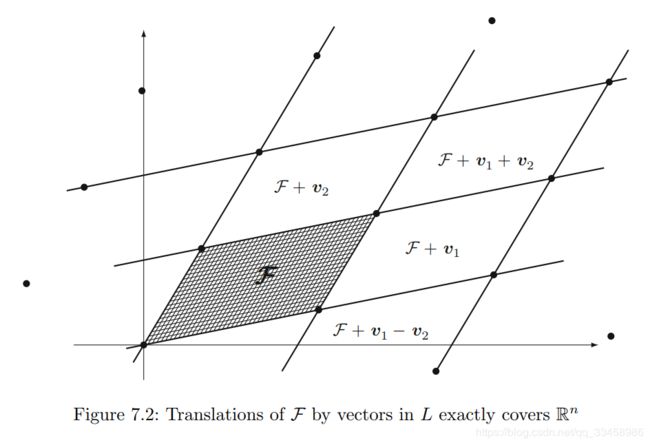
F \mathcal{F} F的Volume(体积?)由下面的定理给出:
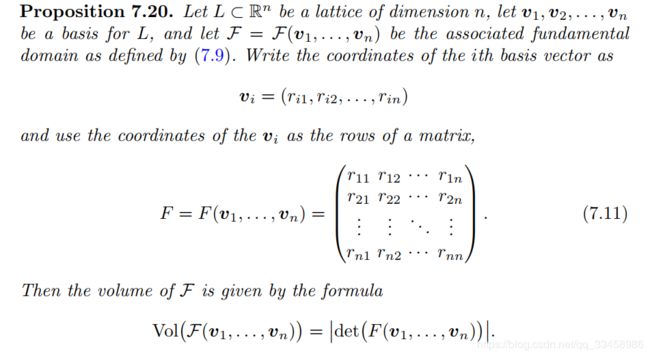
当基向量相互正交, D e t ( L ) = V o l ( F Det(\mathcal{L})=Vol(\mathcal{F} Det(L)=Vol(F)获得最大值
SVP and CVP
SVP:Shortest Vector Problem
CVP:Cloest Vector Problem,给定一个不在 L \mathcal{L} L 中的向量 ω \omega ω,我们需要在 L \mathcal{L} L中找到一个与 ω \omega ω最近的向量
ApprSVP:

寻找SVP和CVP是格理论中最基本的问题,一般而言CVP比SVP更难,例如n维的CVP可以转换为n+1维的SVP问题
Hermite’s Theorem and Minkowski’s Theorem
Hermite定理是关于在 L \mathcal{L} L中的最短非零向量长度的upper bound

对于这一定理有更精确的说明如下:
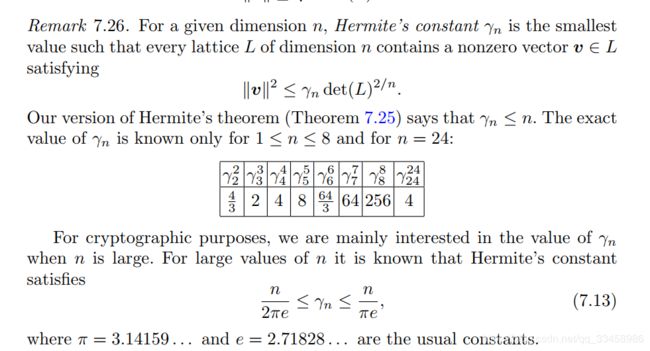
γ n \gamma_n γn是赫米特常数
赫米特定理的证明依赖于闵可夫斯基定理:

这个定理描述了 R n \mathbb{R}^n Rn的一个有界对称凸(甚至于闭)子集S若满足上述的体积与det(L)相关的不等式,那么S会包含L中的向量。
举个具体的例子,在闵可夫斯基定理的百度百科,其中的L具体化为了二维坐标平面,那么坐标平面的n=2,det(L)=1,因此只要S的面积大于等于4,那么S就会至少包含一个横纵坐标都是整数的坐标,也就包含了L中的向量。
The Gaussian Heuristic
The Gaussian Heuristic(高斯启发式?)是对赫米特常数的进一步缩小(从supercube变成supersphere)
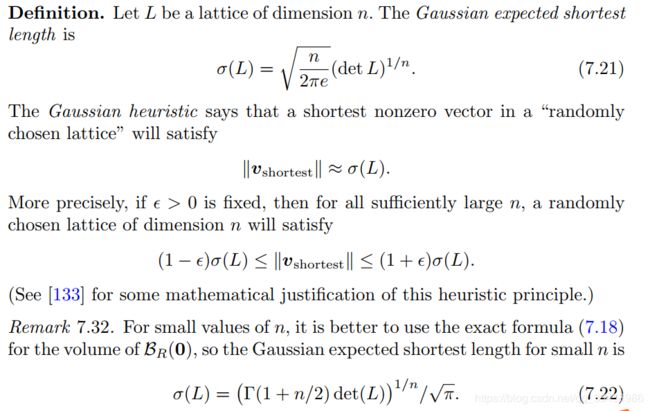
Babai’s Algorithm
这个算法是解决CVP问题的一个算法,下文中求 a i a_i ai的方法其实就是四舍五入。
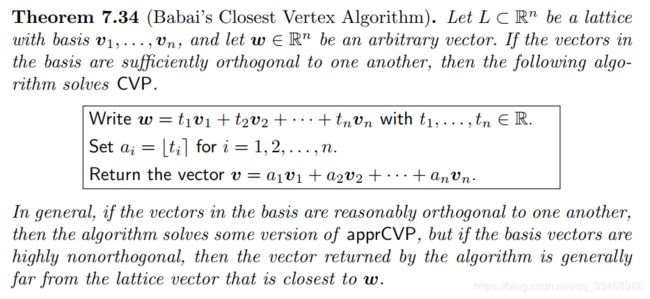
该算法对于一个“好”的基而言比较准确,对于“坏”的基而言就不是很准了,如下图所示,给定一个Target Point,利用上面的算法得到的顶点是Closest Vertex,然而直观来看最近的点应该是下图中的Closest Lattice Point,因此,当你所拥有的基是“坏”的,不容易解出CVP问题。
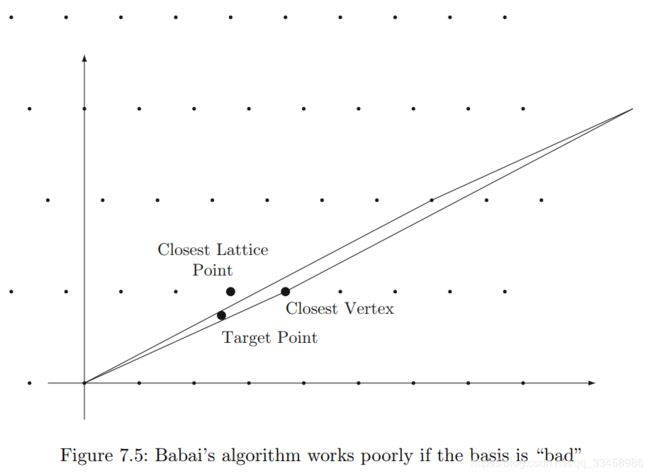
GGH密码
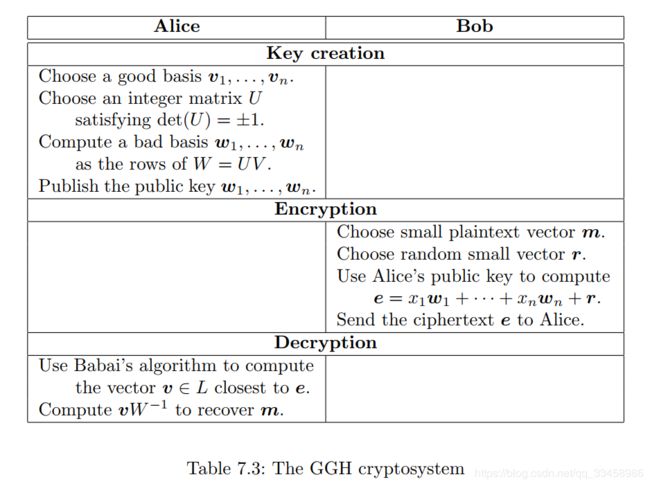
因为公钥是“坏”基,因此对于攻击者而言,使用Babai算法解出 m 可能不太现实。
NTUR密码
NTUR的破解
构建这么一个矩阵:
L h N T R U = ( 1 0 ⋯ 0 h 0 h 1 ⋯ h N − 1 0 1 ⋯ 0 h N − 1 h 0 ⋯ h N − 2 ⋮ ⋮ ⋱ ⋮ ⋮ ⋮ ⋱ ⋮ 0 0 ⋯ 1 h 1 h 2 ⋯ h 0 0 0 ⋯ 0 q 0 ⋯ 0 0 0 ⋯ 0 q q ⋯ 0 ⋮ ⋮ ⋱ ⋮ ⋮ ⋮ ⋱ ⋮ 0 0 ⋯ 0 0 0 ⋯ q ) L_{\boldsymbol{h}}^{\mathrm{NTRU}}=\left(\begin{array}{cccc|cccc} {1} & {0} & {\cdots} & {0} & {h_{0}} & {h_{1}} & {\cdots} & {h_{N-1}} \\ {0} & {1} & {\cdots} & {0} & {h_{N-1}} & {h_{0}} & {\cdots} & {h_{N-2}} \\ {\vdots} & {\vdots} & {\ddots} & {\vdots} & {\vdots} & {\vdots} & {\ddots} & {\vdots} \\ {0} & {0} & {\cdots} & {1} & {h_{1}} & {h_{2}} & {\cdots} & {h_{0}} \\ \hline 0 & {0} & {\cdots} & {0} & {q} & {0} & {\cdots} & {0} \\ {0} & {0} & {\cdots} & {0} & {q} & {q} & {\cdots} & {0} \\ {\vdots} & {\vdots} & {\ddots} & {\vdots} & {\vdots} & {\vdots} & {\ddots} & {\vdots} \\ {0} & {0} & {\cdots} & {0} & {0} & {0} & {\cdots} & {q} \end{array}\right) LhNTRU=⎝⎜⎜⎜⎜⎜⎜⎜⎜⎜⎜⎜⎜⎛10⋮000⋮001⋮000⋮0⋯⋯⋱⋯⋯⋯⋱⋯00⋮100⋮0h0hN−1⋮h1qq⋮0h1h0⋮h20q⋮0⋯⋯⋱⋯⋯⋯⋱⋯hN−1hN−2⋮h000⋮q⎠⎟⎟⎟⎟⎟⎟⎟⎟⎟⎟⎟⎟⎞
可以证明这个Lattice包含了 ( f , g ) (\boldsymbol{f}, \boldsymbol{g}) (f,g)
一个定理: Let ( N , p , q , d ) (N, p, q, d) (N,p,q,d) be N T R U NTRU NTRU Encrypt parameters, where for simplicity we will assume that
p = 3 and d ≈ N / 3 and q ≈ 6 p d ≈ 2 p N p=3 \quad \text { and } \quad d \approx N / 3 \quad \text { and } \quad q \approx 6 p d \approx 2 p N p=3 and d≈N/3 and q≈6pd≈2pN
Let L h N T R U L_{\boldsymbol{h}}^{\mathrm{NTRU}} LhNTRU be an N N NTRU lattice associated to the private k e y ( f , g ) k e y(\boldsymbol{f}, \boldsymbol{g}) key(f,g)
(a) det ( L h N T R U ) = q N \operatorname{det}\left(L_{h}^{\mathrm{NTRU}}\right)=q^{N} det(LhNTRU)=qN
(b) ∥ ( f , g ) ∥ ≈ 4 d ≈ 4 N / 3 ≈ 1.155 N \|(\boldsymbol{f}, \boldsymbol{g})\| \approx \sqrt{4 d} \approx \sqrt{4 N / 3} \approx 1.155 \sqrt{N} ∥(f,g)∥≈4d≈4N/3≈1.155N
(c) The Gaussian heuristic predicts that the shortest nonzero vector in the NTRU lattice has length
σ ( L h N T R U ) ≈ N q / π e ≈ 0.838 N \sigma\left(L_{\boldsymbol{h}}^{\mathrm{NTRU}}\right) \approx \sqrt{N q / \pi e} \approx 0.838 N σ(LhNTRU)≈Nq/πe≈0.838N
Hence if N N N is large, then there is a high probability that the shortest nonzero vectors in L h N T R U L_{\boldsymbol{h}}^{\mathrm{NTRU}} LhNTRUare ( f , g ) (\boldsymbol{f}, \boldsymbol{g}) (f,g) and its rotations. Further,
∥ ( f , g ) ∥ σ ( L ) ≈ 1.38 N \frac{\|(\boldsymbol{f}, \boldsymbol{g})\|}{\sigma(L)} \approx \frac{1.38}{\sqrt{N}} σ(L)∥(f,g)∥≈N1.38
so the vector ( f , g ) (\boldsymbol{f}, \boldsymbol{g}) (f,g) is a factor of O ( 1 / N ) \mathcal{O}(1 / \sqrt{N}) O(1/N) shorter than predicted by the Gaussian heuristic.
根据这个定理我们可以看出 ( f , g ) (\boldsymbol{f}, \boldsymbol{g}) (f,g)大概率是这个格里面最短的向量,因此破解NTUR变成SVP。
LLL算法
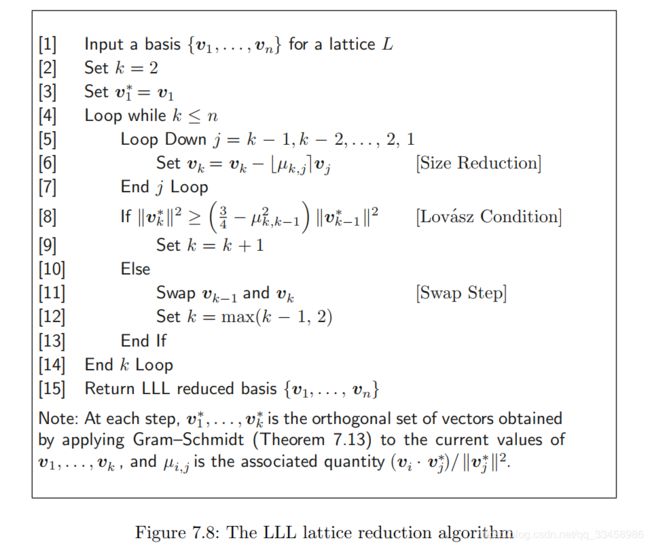
这个算法在Size Reduction的地方有点像施密特正交化(施密特正交化脱离了整数环),下面增加了一步swap以确保满足Lovasz Condition,这样子是为了最后的基大小是从小到大排列,且最小化算法过程中的 d e t L l det L_l detLl( L l L_l Ll是由 v 1 , . . . , v l v_1,...,v_l v1,...,vl生成的 s u b L a t t i c e ) subLattice) subLattice)
在sage中使用LLL算法:
sage: M=Matrix(ZZ,[(1, 39245579300),(0, 122430513841)])
sage: M.LLL()
[-231231 -195698]
[-368222 217835]
使用LLL算法就可以破解比较低维的以上密码,具体例子参见课本
